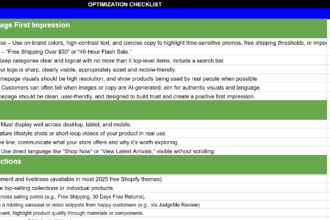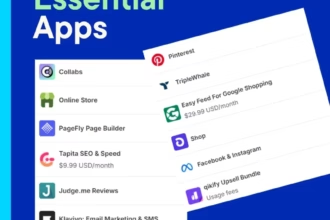A Beginners’ Guide to Understanding and Measuring Conversions in eCommerce
In the digital marketplace, improving your online store is similar to how a physical shop arranges products to encourage more sales. But what exactly does it mean to “convert” online visitors?
Simply put, a conversion happens when someone visits your website and completes a desired action—like making a purchase or subscribing to your newsletter. To make your online store successful, you need to clearly understand, track, and improve these conversions.
Let’s break it down step by step, using examples from small and medium-sized brands across Asia.
Understanding Key Conversion Metrics
1. Conversion Rate: Turning Visitors into Buyers
Your conversion rate is the percentage of visitors who complete a desired action (like buying a product) out of all visitors. It’s a key indicator of your store’s overall effectiveness.
For example, if 100 people visit your site and 5 people buy something, your conversion rate is 5%.
Tip: Tools like Google Analytics can help you track this easily.
2. Average Order Value (AOV): Maximizing Every Sale
The Average Order Value (AOV) measures the average amount customers spend per order. Raising this number means making more money without necessarily attracting more customers.
Brands can improve AOV by:
Offering bundles or package deals
Suggesting related products (cross-selling)
Promoting upgrades (upselling)
Example: Singapore-based snack brand Amazin’ Graze often uses product bundles and limited-time promotions to boost their AOV.
3. Customer Lifetime Value (CLV): Building Long-Term Relationships
The Customer Lifetime Value (CLV) represents the total revenue you can expect from a single customer over time. Increasing CLV means encouraging repeat purchases and building customer loyalty.
Brands can enhance CLV by:
Providing excellent customer service
Creating loyalty programs
Offering personalized recommendations
Example: Malaysian skincare brand LUMI Beauty uses personalized promotions and reward programs to keep customers returning, boosting their CLV significantly.

Tools for Tracking and Improving Conversions
Google Analytics: Your Essential Toolkit
Google Analytics is the most common tool for tracking conversions. It helps you understand customer behavior, see where people leave your site, and pinpoint areas for improvement.
For instance, if Google Analytics shows visitors abandoning their carts at checkout, you know to simplify your checkout process or provide more payment options.
Built-in Platform Analytics
E-commerce platforms like Shopify and WooCommerce have built-in analytics. These tools give quick insights into your sales, popular products, and customer behavior, helping you make smarter decisions without complicated setups.
Heatmap Tools: Seeing Through Customers’ Eyes
Tools like Hotjar or Crazy Egg visually show how customers interact with your website—where they click, scroll, or hesitate—helping you identify problem areas quickly.
Case Studies from Asian Brands
1. Improving Sales with A/B Testing: Pomelo Fashion (Thailand)
Thai clothing brand Pomelo Fashion frequently uses A/B testing—experimenting with different product page layouts. By optimizing product descriptions and making reviews more visible, Pomelo increased their conversions significantly.
2. Reducing Cart Abandonment: IUIGA (Singapore)
Singapore-based homeware brand IUIGA noticed customers dropping off during checkout. By simplifying the checkout form and clearly displaying shipping information, IUIGA saw a significant reduction in cart abandonment and increased conversions.
3. Boosting AOV with Cross-Selling: Love, Bonito (Singapore)
Women’s fashion brand Love, Bonito successfully increased their Average Order Value by suggesting accessories and matching products during checkout, resulting in a substantial rise in revenue per order.
4. Mobile Optimization Success: Althea (Korea)
Korean beauty retailer Althea revamped its mobile website, making it faster and easier to navigate. After the update, Althea saw a substantial boost in mobile sales, highlighting the importance of mobile-friendly designs.
Effective Strategies to Improve Conversions
1. Website Optimization: Making Your Store Fast and Easy
Customers prefer quick-loading, easy-to-navigate websites. Slow websites cause visitors to leave quickly. Use tools like Google PageSpeed Insights to check your site’s speed and fix any issues slowing it down.
2. A/B Testing: Learning What Works Best
A/B testing helps you experiment safely by testing different versions of your pages to see what customers prefer. Tools like VWO or Optimizely can easily run these experiments for you.
3. Customer Feedback: Listen and Improve
Customer feedback is crucial. Using surveys or feedback forms through Typeform or SurveyMonkey can tell you directly what customers want or where they face problems.
4. Smart Upselling and Cross-Selling: Increase Order Value
Encourage customers to buy more by showing related or complementary products during checkout. For example, if someone buys shoes, suggest matching socks or shoelaces.
Lessons and Best Practices
From these examples, remember these key lessons:
Test regularly: Even small improvements can greatly impact sales.
Understand customer journeys: Analyze your site to make the shopping experience as smooth as possible.
Encourage bigger purchases: Thoughtful upselling and cross-selling increase your average sale amount.
Always optimize for mobile: Many shoppers browse on their phones, so your site must be mobile-friendly.
Conclusion
Improving your online store’s conversions is not a one-time job—it’s an ongoing effort. By consistently monitoring key metrics, listening to your customers, updating your Shopify store and applying the right strategies, you ensure continued growth.
Small and medium Asian brands, such as Pomelo Fashion, IUIGA, Love, Bonito, and Althea, prove that understanding and improving conversions can lead to significant business success.
Soodo
Soodo | Shopify Website Development





